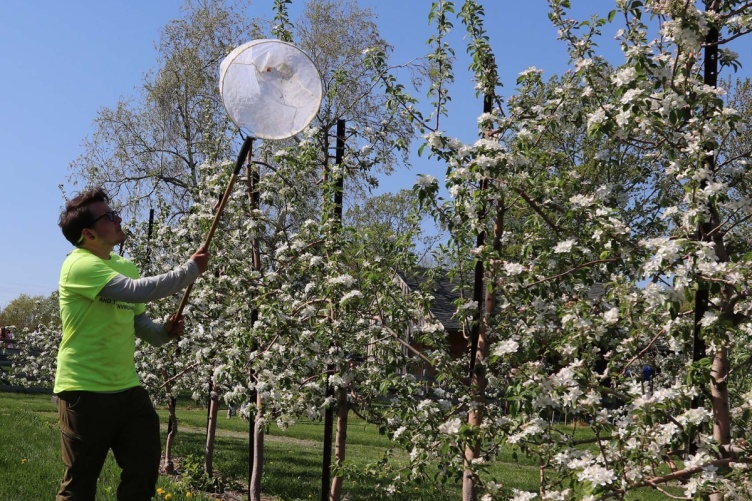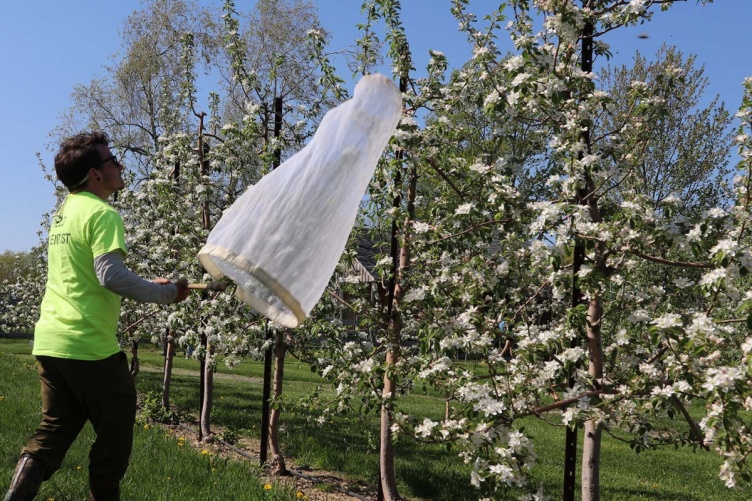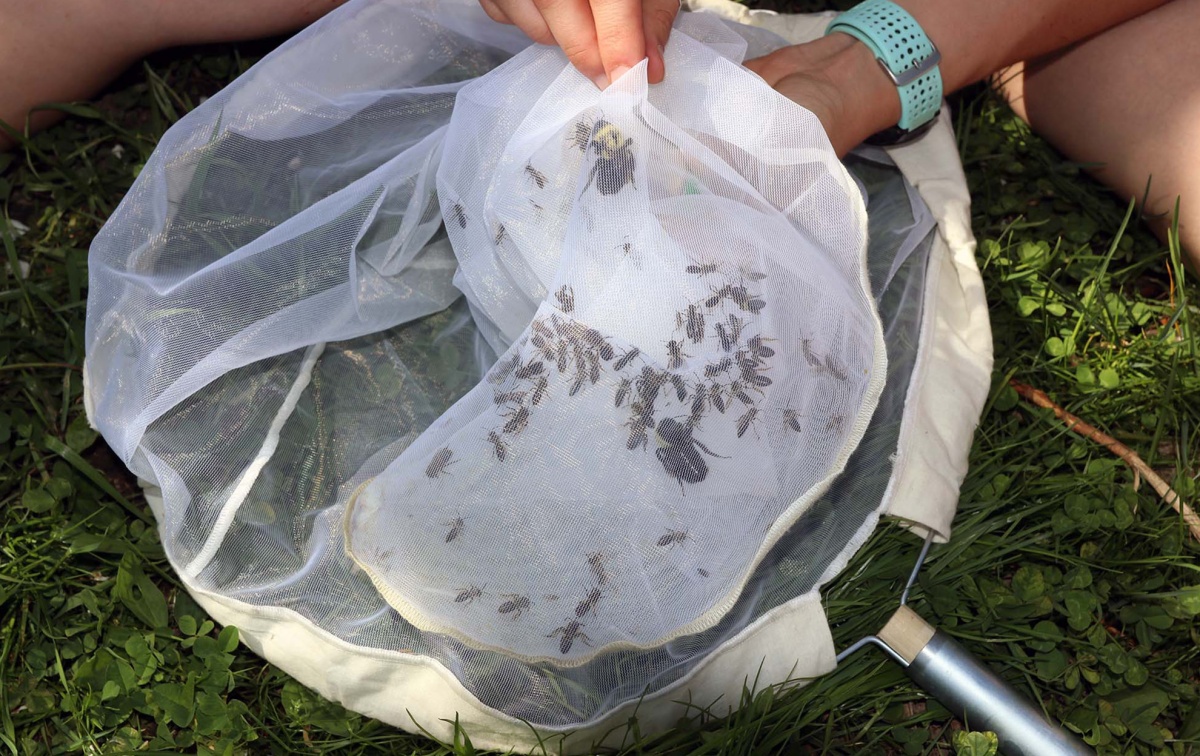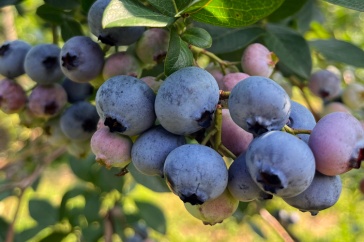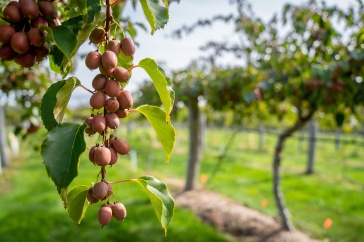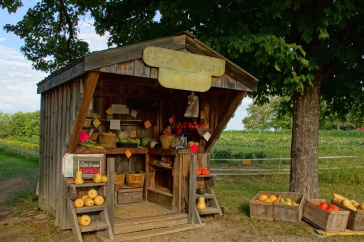Research Goals:
Catalog native and nonnative bee species active in New Hampshire apple orchards during the spring bloom to:
- Identify and categorize the diversity of bee species across the Granite State, and
- Draw connections between farming practices and species within orchards.
Undergraduates Working on Real-World Problems:
Shyloh Favreau’s research offers an important opportunity for other UNH students to engage in and learn about key principles of running their own experiments. Favreau’s work is assisted by undergraduate students, including Kate Agostini and Santino Marchesano, in the UNH sustainable agriculture and food systems (SAFS).
“Getting involved in research projects as an undergrad is probably the most immersive experience I’ve had while at UNH,” said Agostini, a double major in SAFS and economics and the former farm manager for UNH’s Organic Garden Club. “I’m seeing the problems that farmers and other operations face and that researchers are trying to solve—as well as the processes that go into finding solutions through research.”
For Marchesano, a student worker with the UNH Collection of Insects and Other Arthropods, assisting Favreau offers him an opportunity to apply lab-based research in a field study.
“With the insect collection, I studied and categorized different bee species,” Marchesano said. “Now I am helping to identify our native bee species in the field!”
Shyloh Favreau skillfully swings an insect collection net along a row of mature apple trees in an orchard in southern New Hampshire. He walks down the row, tracing the net back and forth next to the apple trees, joking that his lacrosse skills are finally being put to good use while he avoids disrupting the recent white blossoms covering each tree. Favreau’s research goals are to understand how Granite State farmers’ management of their crops affects bee populations, which in turn, help food producers succeed. The work supports NH Agricultural Experiment Station scientist Rich Smith’s broader research goals of improving the quantity and quality of ecosystem services derived from agriculture.
This work represents the close integration of the three pillars of UNH's land-grant mission: research, teaching and extension. As Favreau’s research helps move Station science forward, it is part of his studies in the UNH College of Life Sciences and Agriculture (COLSA) natural resources master’s program and is informed by his experience in the UNH Cooperative Extension.
Why Types of Bees Are in New Hampshire Orchards?
“Through my role with Extension, I’ve worked with New Hampshire farmers, many of whom expressed an interest in knowing the types of bees that they have on their farms,” says Favreau, who is also the diagnostic services program manager for UNH Plant Disease & Diagnosis Services lab. “All these different bee species have different needs, and the farmers want to know which species are out there helping them create their product and make a profit.”
He adds, “Another goal is to look at the growing practices employed at these different orchards to identify trends or patterns that potentially result in the presence or absence of different bee species.”
Apples are one of the Granite State’s top-produced agricultural commodities. According to USDA Census data, New Hampshire is home to 228 farms that grow 50 varieties of apples across nearly 1,500 acres of land. In 2017, Granite State apple farmers harvested a crop valued at upwards of $8.6 million.
Back at the orchard, Favreau’s net has dozens of buzzing insects—mostly bees—that represent a sample of different native and nonnative species ranging from the more easily identifiable European honeybee (Apis mellifera) and eastern bumble bee (Bombus impatiens) to the lesser-known mason (Osmia bicornis) and carpenter (Xylocopa genus) bees. Favreau, whose research focus is in environmental conservation and sustainability, is in the middle of a two-week data collection sprint when New Hampshire apple trees bloom. The study requires long days—sometimes surveying at as many as three orchards per day—while crisscrossing the state to capture data at 25 different orchards and ensuring that he doesn’t miss this narrow window, which can vary in different parts of New Hampshire.
“I wanted to make sure I collect only when the blooms are present so that I can share with the farmers what bee pollinators are active during this time,” says Favreau, still swinging his net as he nears the end of the row. “Different bees are out at different times of the year. However, many bee species that are out during the bloom, helping to pollinate apples and other plants, may not be around later in the year or even later in the month—so it’s important to sample during this time.”
A Team Effort
Fortunately, Favreau is supported by a team that includes graduate and undergraduate COLSA students, as well as Extension specialists and the farmers themselves. At each orchard, Favreau and his team employ a combination of active and passive data collection. The active method—the netting—is conducted at least twice per day along three different 100-meter-long transects, with three 15-minute collection events (or passes with the net) being performed along each transect. The three transects represent three different parts of the orchard: the middle, an edge and along a row of McIntosh Reds—a variety that nearly every regional orchard grows. Passive collection involves using bright-yellow plastic bowls filled with soapy water to attract bees.
Once completed, Favreau and his team will have conducted 18 collection events per farm, or 450 in total. Overall, they will have collected bee species from orchards in all 10 Granite State counties.
Left: At a New Hampshire orchard, a row of apple trees are in full bloom. Right: A variety of bees caught in a net. The researchers categorized a sampling of the bees at 25 orchards across New Hampshire.
“I love bees,” Favreau says. “I did some undergraduate research on bees, and honestly I’m curious—I want to know how the bee communities around the state are similar or different.”
“I know a lot about bees,” he adds, “and I hope that by the end of this I’ll know a hell of a lot about apples, too.”
“So many of our favorite local and regional foods, including apples, rely on there being an adequate abundance of bees,” says Smith, an associate professor in the natural resources and the environment department and Favreau’s master’s thesis adviser. “Unfortunately, we also know that across the globe, pollinator numbers are declining.”
“Shyloh’s work will shed new light on the health of bee communities here in New Hampshire and will provide apple growers in our state and elsewhere with knowledge of the specific types of bees that visit orchards,” Smith adds, “as well as insight into the farm management practices that are likely to help protect bee populations.”
This material is based on work supported by the NH Agricultural Experiment Station through joint funding from the USDA National Institute of Food and Agriculture (under Hatch award number 7000871) and the state of New Hampshire.
-
Written By:
Nicholas Gosling '06 | COLSA/NH Agricultural Experiment Station | nicholas.gosling@unh.edu

















































